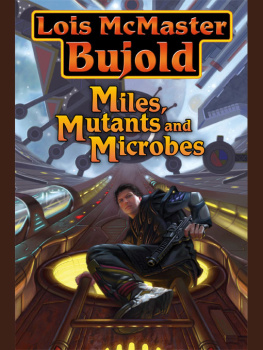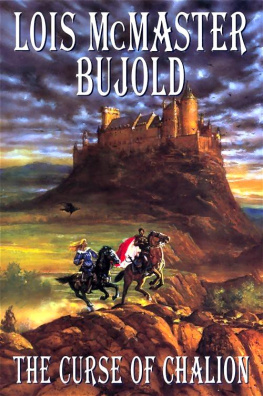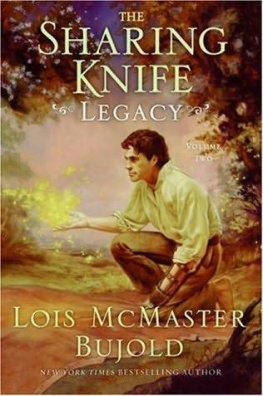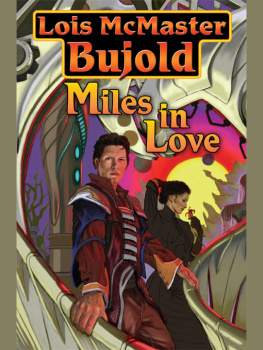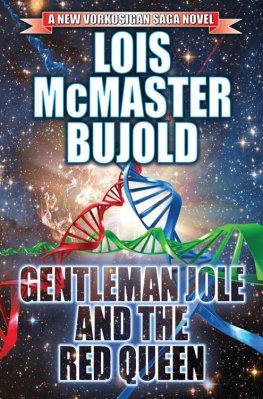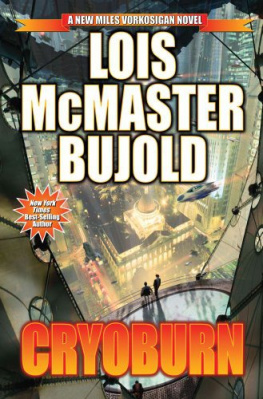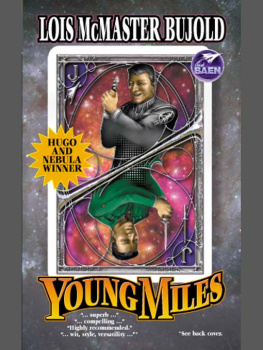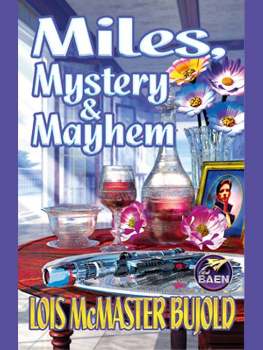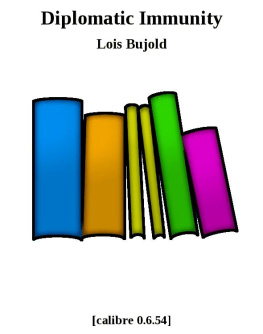Miles, Mutants and Microbes
Lois McMaster Bujold
This is a work of fiction. All the characters and events portrayed in this book are fictional, and any resemblance to real people or incidents is purely coincidental.
Preface copyright 2007 by Lois McMaster Bujold. Falling Free copyright 1988 by Lois McMaster Bujold; "Labyrinth" copyright 1989 by Lois McMaster Bujold; Diplomatic Immunity copyright 2002 by Lois McMaster Bujold.
Vorkosigan is a registered trademark of Lois McMaster Bujold.
All rights reserved, including the right to reproduce this book or portions thereof in any form.
A Baen Books Original
Baen Publishing Enterprises
P.O. Box 1403
Riverdale, NY 10471
www.baen.com
ISBN 10: 1-4165-2141-0
ISBN 13: 978-1-4165-2141-9
Cover art by Alan Pollack
First printing, August 2007
Distributed by Simon & Schuster
1230 Avenue of the Americas
New York, NY 10020
Library of Congress Cataloging-in-Publication Data
Bujold, Lois McMaster.
Miles, mutants & microbes / Lois McMaster Bujold.
p. cm.
"A Baen Books original"T.p. verso.
ISBN 1-4165-2141-0 (hc)
1. Vorkosigan, Miles (Fictitious character)Fiction. 2. Science fiction, American. I. Title. II. Title: Miles, mutants and microbes.
PS3552.U397M56 2007
813'.54dc22
2007018794
Pages by Joy Freeman (www.pagesbyjoy.com)
Printed in the United States of America
Baen Books by Lois McMaster Bujold
The Vorkosigan Saga:
Shards of Honor
Barrayar
The Warrior's Apprentice
The Vor Game
Cetaganda
Borders of Infinity
Brothers in Arms
Mirror Dance
Memory
Komarr
A Civil Campaign
Diplomatic Immunity
Falling Free
Ethan of Athos
Omnibus Editions:
Cordelia's Honor
Young Miles
Miles, Mystery & Mayhem
Miles Errant
Miles, Mutants & Microbes
Miles in Love (forthcoming)
Preface
My author's preface for this collection is both a history, and an apologiaa word which means not an expression of regret for a fault, but a speech in defense. (What I'll be defending is my selection criteria for assembling this grouping of tales, and it will mainly be of interest to old Bujold readers.)
New readers need have no fear: dive right in! The stories here will explain themselves as they go. In this volume you will find two novels and a novella from what, due to my reluctance to coin a suitably imposing-sounding series name, its fans have eventually dubbed "the Vorkosiverse," after its most memorable and central (but far from only) character and his family. Science fiction and fantasy are the only genres I know where a series is defined by what universe it is set in (making mainstream fiction, looked at with the right squint, the world's largest shared-universe series). All the tales under this cover belong in the same "future history," if at widely divergent times.
What links them, mostly, are the quaddies, a race of humans bioengineered to live in zero-gravity that you will meet in the kick-off novel for this omnibus, Falling Free. This book falls early both in the timeline of its universe and in my career; it was the fourth novel I ever wrote and also the fourth published, and won both my first appearance in the venerable Analog Magazine and my first Nebula award. Taking place some two hundred years before the main body of stories, in it Barrayar (and the Vorkosigans) have not yet been discovered by the universe at large. The second tale, the novella "Labyrinth," introduces both a new quaddie character, and Miles Vorkosigan in his "Admiral Naismith" hat. (He has more than one persona, sprawling over several books, but I think you'll get enough about him in the novella to go on with; it was written to stand alone and indeed also appeared as a self-contained story in Analog.) The third tale, Diplomatic Immunity, as of this writing the most recent of my Vorkosiverse novels, brings elements of the first two tales around to meet again, in much more depth and detail.
At this point, the new reader is most welcome to stop reading this introduction and go read the real stories, which will be much more fun. You can circle back later for the "how these came to be written" part, which will then make much more sense. Anyone who still wants more orientation (though I don't think it will be needed) can have a peek at the series timeline included in the back of this volume. Don't be daunted by the accumulation; due to my decision to write all these books, though linked, as potential stand-alones, you don't have to read them in order or all at once.
Old readers will note that the novella "Labyrinth" also appears in the Baen omnibus Miles, Mystery & Mayhem, in its due position in a strict series timeline. Up until the novel Memory, the series grouped in internal-chronological order in a very tidy fashion, with two novels and a novella for each collection. (With the exception of the first, Cordelia's Honor, which is more the re-marriage of two halves of one intended tale, as explained in its afterword.) From Memory on, however, there was no way to make the books divide up evenly no matter how they were sliced. All the grouping schemes had a different defect: too much text, too little, the separation of strongly thematically linked tales that truly belonged together, and so on.
So the repackaging effort stalled out for a long time. But when the time came around on the guitar again to relicense the books, I was finally inspired to cut the Gordian knot in this fashion: the pivotal Memory left as a stand-alone, the Miles-and-Ekaterin sequence collected together in the upcoming Miles in Love (an inevitable title if ever there was one), and the quaddie-linked tales put together, here.
You are notall you internet complainers, and you know who you arebeing ripped off by your faithful publisher by being tricked into buying the same story twice. Due to the vagaries of tree-ware economics, this volume would have been the exact same price (if much less comprehensible) if the novella hadn't been included at all. It's being thrown in for free as a gift to the new readers. And it was my idea, so don't kvetch at Publisher Toni. (You can kvetch at me, I suppose; I hang out pretty regularly on Baen's Bar in the "Miles to Go" conference, so I'm not too hard to find.) This was an artistic decision, not an economic one.
So there. On to the history.
Falling Free actually came to be written as a result of a phone conversation with Jim Baen. I had written my first three science fiction novels "on spec," that is, without a prior contract or even contact with a publisher, which is pretty much the norm for first-time novelists. They sold on one memorable day in October, 1985, in my very first phone conversation with Jim, when, after reading The Warrior's Apprentice, he called me up and offered for all three books. I was then faced, for the first time, with writing a novel with a known publishing destination, and intimidating expectations.
I had been thinking of following up a minor character from The Warrior's Apprentice named Arde Mayhew, a jump pilot afflicted with obsolete neural implant technology who would be on a quest for a ship that would fit him. I pictured him finding his prize among a group of people dwelling in an asteroid belt whose ancestors were bioengineered to live in free fall, and who were eking out a living, among other ways, as interstellar junk dealers. Jim was not much taken with Arde, but he seemed to perk up when I came to describe my proto-quaddies, and opined that a tale about them might be more interesting and science fictional. We all know what happens when technological obsolescence hits the products of engineering; what would happen if (always a key SFnal question) technological obsolescence hit the products of bioengineering?

